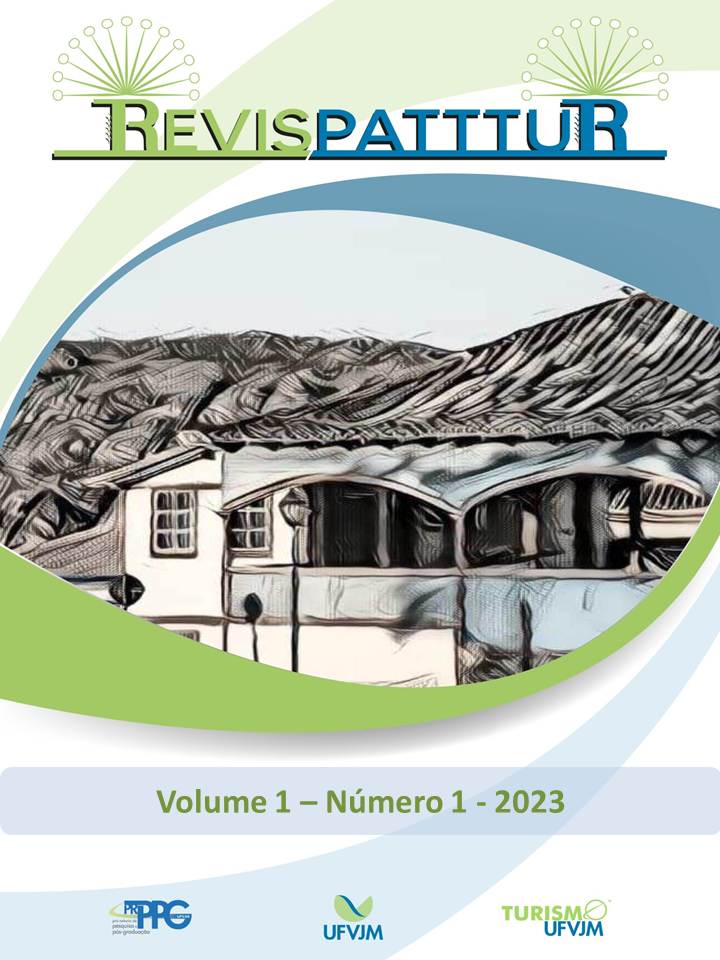Analysis of tourist attractions in the districts surrounding the Sempre-Vivas National Park
DOI:
https://doi.org/10.5281/zenodo.10179538Keywords:
tourist inventory, locally-based tourism, Inhaí, Curimataí, São João da ChapadaAbstract
The Sempre-Vivas National Park (PNSV) was created in 2002, located in the Serra do Espinhaço, partially covering the following municipalities: Diamantina, Bocaiúva, Buenópolis e Olhos Dágua, in the region of Transespinhaço Trail. The structuring of this section of this trail that passes within the PNSV connecting Inhaí to Curimataí is considered one of the priority needs in the Consultative Council of the Park (CONVIVAS), and was the basis for defining the main objective of this research in partnership with the Tourism Program of the UFVJM, to identify and analyse the offer of tourist attractions in Inhaí, Curimataí and São João da Chapada districts, around the PNSV. As a descriptive research, it includes data collection via bibliographical and documentary research, and field work. A total of 112 attractions were inventoried, divided into natural and cultural attractions, and scheduled events, showing significant tourist potential of the districts. In such a way, the project objectives were encompassed, insofar as the compiled data may assist management bodies and the communities involved in defining local development strategies.
References
Brasil. (2018). Serra do Espinhaço terá trilha de longo curso. Recuperado de: https://www.gov.br/icmbio/pt-br/assuntos/noticias/ultimas-noticias/serra-do-espinhaco-tera-trilha-de-longo-curso
Instituto Chico Mendes de Conservação da Biodiversidade – ICMBio. (2016a). Plano de Manejo do Parque Nacional das Sempre-Vivas. Brasília.
Instituto Chico Mendes de Conservação da Biodiversidade – ICMBio. (2016b). Plano de Ação do Conselho Consultivo do Parque Nacional das Sempre-Vivas (CONVIVAS). Diamantina/MG.
Ferreira, P. L., Scalco, R. F., & Martins Fonseca, V. (2022) O Inventário da oferta turística como estratégia de diálogo com a comunidade: Um estudo de caso sobre o Parque Nacional das Sempre-Vivas e seu entorno. Revista Biodiversidade Brasileira, 1, 284-304.
Martins, M. L. (2020). A economia da “sempre-viva” em São João da Chapada (Diamantina, MG), meados do século XX. Revista Brasileira de História & Ciências Sociais, 11(22), 235–262. Recuperado de https://periodicos.furg.br/rbhcs/article/view/10818
Ministério do Turismo (2011). Inventário da Oferta Turística. Ana Clévia Guerreiro Lima (Coordenador). Brasília.
Ruschmann, D. V. M. (2006). Turismo e planejamento sustentável: A proteção do meio ambiente. 13ª edição. Campinas: Papirus.
Universidade Federal de Minas Gerais – UFMG. (2018a). Inventário dos serviços turísticos e da infraestrutura de Inhaí, Curimataí e São João da Chapada: Relatório final de projeto de pesquisa. Curso de Turismo. Instituto de Geociências, UFMG. Belo Horizonte.
Universidade Federal de Minas Gerais – UFMG. (2018b). Inventário de serviços turísticos e infraestrutura, Distrito de Curimataí. Curso de Turismo. Instituto de Geociências, UFMG. Belo Horizonte.
Universidade Federal dos Vales do Jequitinhonha e Mucuri – UFVJM. (2017). Plano de Desenvolvimento Institucional: 2017–2021. Diamantina/MG.
Downloads
Published
How to Cite
Issue
Section
License
Copyright (c) 2023 Revista de Turismo: Patrimônios, Territórios Descoloniais e Trabalho

This work is licensed under a Creative Commons Attribution-NonCommercial 4.0 International License.
CC BY-NC 4.0





